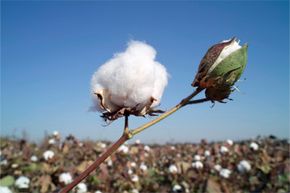How Denim Insulation Is Made
Humans have a long and storied history with cotton. Before we transform a pair of jeans into insulation, let's figure out how denim is made.
Everything begins with cottonseed, which germinates into a small plant that sends up creamy, white flowers about three months after planting. After changing color, the flowers wither and die, leaving green pods known as cotton bolls. This is where it starts getting hairy. Inside the boll, a tangle of fibers grows around the forming seeds. These fibers are where T-shirts, briefs and jeans begin their lives. The warm sun causes the fibers to expand until, finally, they rupture the boll and burst forth like popcorn erupting in hot oil.
Advertisement
During harvesting, cotton-picking machines remove the seed cotton from the plant. A process known as ginning separates the seeds from the fibers and results in bales that make their way to textile mills specializing in yarn manufacturing. This involves raking debris from the fibers, straightening the fibers into a continuous strand called sliver and then spinning the sliver into yarn. Looms weave cotton yarns into fabrics by interlacing lengthwise strands known as the warp with crosswise strands known as the filling. These fabrics then arrive at finishing plants, where they are preshrunk, dyed and transformed into denim. Finally, denim manufacturers produce the clothing we buy.
After a few months or years, most people are ready to retire their old jeans for something spiffier. This is where denim recycling comes in (more on those logistics later). First, workers must separate the denim from other materials and then remove any zippers, buttons and hardware from the fabric, in the same way that you remove staples from paper before you shred it. Next, it heads for large shredders that grind the material to pieces. The chewed-up denim moves to a baler, which produces 1,000-pound (454-kilogram) bales. Trucks then haul the bales to a second processor that, basically, unweaves the denim, returning the textile to its original fiber state.
This is the raw material, which looks a bit like blue cotton candy, that arrives at Bonded Logic. Once there, workers treat the fabric with a borate solution so the insulation won't burn and so it will repel mold and mildew. Next, they mix the material with another fiber and bond everything together in a large oven. Finally, they press the material into 2-inch (5-centimeter) thick rolls and cut the product into its shipping size.
Up next, we'll pit blue against pink -- denim against fiberglass -- to see if a house decked out in blue jeans can really achieve thermal efficiency.
